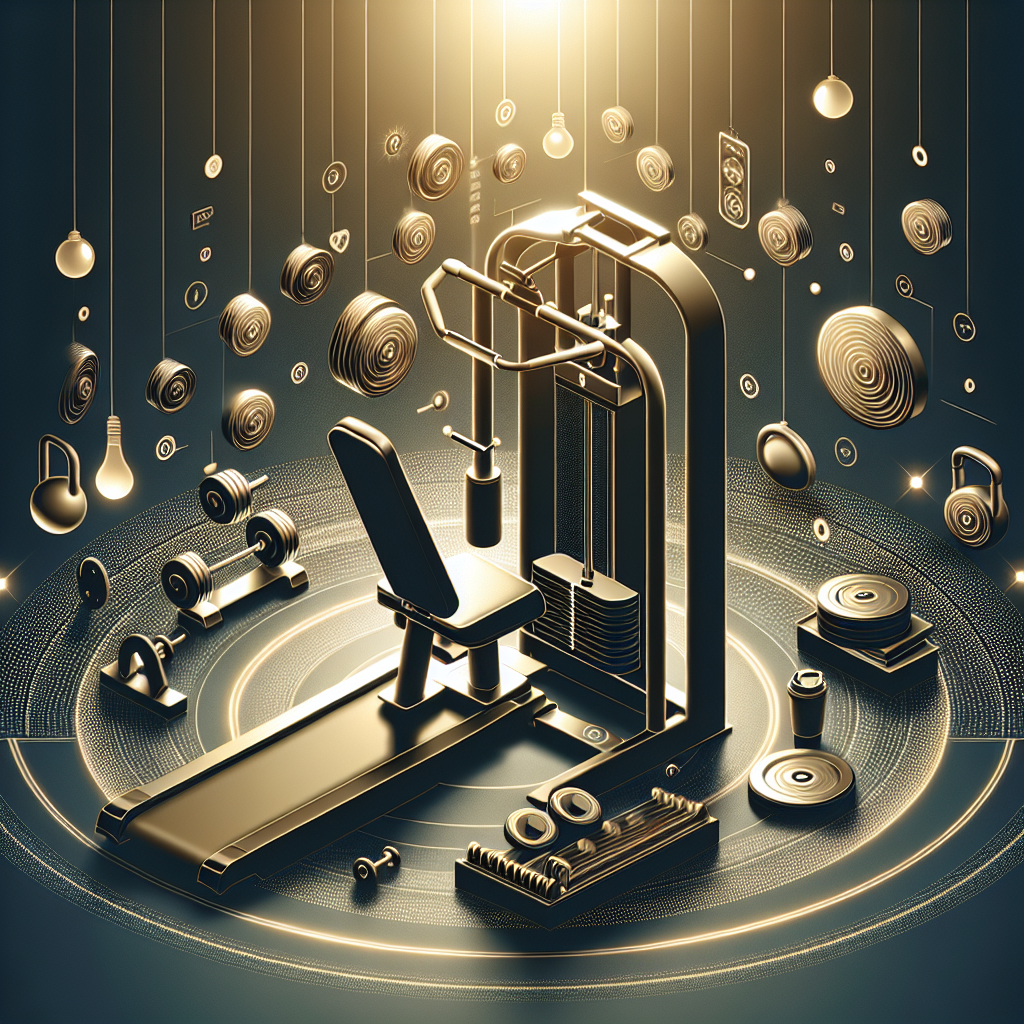With the ever-increasing popularity of fitness and gym culture, finding effective workout routines that maximize results has become a priority for many individuals. In this article, the focus is on effective machine gym workouts. By examining modern gym machines, their costs, and comparing their benefits, this article aims to provide a comprehensive overview of the diverse options available to fitness enthusiasts. Whether one is a beginner or an experienced gym-goer, the following insights will serve as valuable guidance to ensure a productive workout experience.
Benefits of Machine Gym Workouts

Increased safety and reduced risk of injury
One of the key benefits of machine gym workouts is the increased safety and reduced risk of injury compared to free weight exercises. Machines are designed with built-in safety features such as weight stacks, adjustable seats, and safety pins, which help to minimize the risk of accidents or injuries. These features allow users to control the range of motion and stabilize their movements, reducing the chances of straining or overextending their muscles. Furthermore, machines often have clear instructions and diagrams, making them accessible even to those who are new to strength training.
Targeted muscle isolation
Machine gym workouts offer the advantage of targeted muscle isolation, allowing individuals to focus on specific muscle groups. Each machine is designed to target a specific muscle or group of muscles, making it easier to isolate and work on those areas. For example, the leg press machine targets the quadriceps, hamstrings, and gluteal muscles, while the chest press machine targets the pectoral muscles. This targeted approach is particularly beneficial for individuals who have specific goals or areas they want to develop, such as bodybuilders or athletes looking to enhance their performance in a particular sport.
Ease of use and accessibility
Another advantage of machine gym workouts is their ease of use and accessibility. Machines are typically designed to be user-friendly and require minimal instruction or guidance. Users can easily adjust the settings, such as seat height or weight resistance, to fit their needs and preferences. This accessibility makes machines suitable for a wide range of individuals, including beginners or those with limited experience in strength training. Additionally, machines are often equipped with clear instructions and diagrams, making it easier for individuals to learn proper form and technique.
Choosing the Right Machines
Consider your fitness goals
When choosing machines for your gym workouts, it is important to consider your fitness goals. Different machines target different muscle groups and provide varying levels of resistance. For example, if your goal is to build strength and muscle mass in your lower body, you may want to prioritize machines such as the leg press or the seated row. On the other hand, if you are looking to develop your upper body strength, machines such as the chest press or shoulder press would be more suitable. By identifying your goals, you can select the machines that will best help you achieve them.
Assess your current fitness level
Before selecting machines for your gym workouts, it is crucial to assess your current fitness level. Some machines may have weight limitations or specific adjustments that may not be suitable for beginners or individuals with certain limitations or injuries. It is important to consult with a certified personal trainer or healthcare professional who can assess your fitness level and provide guidance on which machines would be appropriate for you. This assessment will ensure that you choose machines that align with your current abilities and avoid potential injuries or setbacks.
Seek expert advice
If you are unsure about which machines to choose for your gym workouts, it is always beneficial to seek expert advice. Certified personal trainers or fitness professionals can provide valuable insights based on their experience and knowledge. They can assess your goals, fitness level, and any specific considerations you may have, and recommend the most suitable machines for your needs. Additionally, they can guide you in using the machines correctly and help you develop an effective workout plan that incorporates the machines to maximize your results.
Costs of Machine Gym Workouts
Initial equipment investment
One consideration when it comes to machine gym workouts is the initial equipment investment. Unlike free weight exercises that can be performed with minimal equipment, machine workouts require access to specific machines. Depending on your goals and preferences, this may involve investing in a variety of machines, such as leg press, chest press, lat pulldown, seated row, and shoulder press machines, among others. These machines can vary in cost, with some being more affordable and others requiring a substantial investment. It is important to research and compare different options before making a purchase to ensure you are getting the best value for your money.
Maintenance and repair costs
In addition to the initial equipment investment, machine gym workouts also come with maintenance and repair costs. Machines require regular maintenance to ensure they are functioning properly and to extend their lifespan. This may involve lubricating moving parts, adjusting cables, and replacing worn-out components. Additionally, machines can experience wear and tear over time and may require repairs or replacement parts. It is important to factor in these ongoing costs when considering the overall expenses of machine gym workouts.

Membership fees and monthly expenses
For individuals who do not have access to their own machines, another cost consideration is the membership fees and monthly expenses associated with using machine gym facilities. Many gyms charge a monthly or annual membership fee that grants individuals access to a variety of machines and equipment. These fees can vary depending on the location, amenities, and services provided by the gym. It is important to compare different gym options in your area to find one that fits within your budget and offers the machines and facilities you desire.
Popular Machine Gym Workouts
Leg Press
The leg press machine is a popular choice for individuals looking to target their lower body muscles, including the quadriceps, hamstrings, and gluteal muscles. This machine involves pushing a weighted platform away from the body using the legs, mimicking the motion of a squat. The leg press allows individuals to safely and effectively strengthen their leg muscles without putting excessive strain on the back or knees, making it suitable for those with joint or stability issues.
Chest Press
the chest press machine is designed to target the pectoral muscles, as well as the triceps and anterior deltoids. This machine involves pushing a lever or handles away from the body, simulating the motion of a bench press. The chest press is an effective exercise for developing upper body strength and muscle definition in the chest area. It offers a controlled and stable movement, reducing the risk of injury and allowing individuals to focus on proper form and muscle activation.
Lat Pulldown
The lat pulldown machine is specifically designed to target the latissimus dorsi muscles, also known as the “lats.” This exercise involves pulling a weighted bar down towards the chest while seated, engaging the muscles in the upper back and shoulders. The lat pulldown machine offers a safe and effective way to strengthen and tone the back muscles, helping to improve posture and overall upper body strength.
Seated Row
The seated row machine is another popular choice for targeting the muscles in the back, particularly the rhomboids, trapezius, and rear deltoids. This exercise involves pulling a handle or cable towards the body while seated, engaging the muscles in the mid and upper back. The seated row machine helps to improve back strength and posture, while also targeting the biceps and forearms.
Shoulder Press
The shoulder press machine is designed to target the muscles in the shoulders, specifically the deltoids. This exercise involves pushing a lever or handles upwards, simulating the motion of a shoulder press with dumbbells or a barbell. The shoulder press machine provides a stable and controlled movement, allowing individuals to safely and effectively strengthen their shoulder muscles.
Creating an Effective Machine Gym Workout
Warm-up and stretching
Before starting any machine gym workout, it is crucial to warm up the muscles and prepare the body for exercise. This can be done through a combination of cardiovascular exercises, such as jogging or cycling, and dynamic stretching. Warming up increases blood flow to the muscles, improves flexibility, and reduces the risk of injury during the workout. Additionally, stretching after the workout helps to cool down the muscles, prevent post-workout soreness, and improve overall flexibility.
Choosing the right weight and resistance
To create an effective machine gym workout, it is important to choose the right weight and resistance for each exercise. The weight or resistance should be challenging enough to stimulate muscle growth and strength gains, but not so heavy that it compromises proper form and technique. It is recommended to start with a weight or resistance that allows for proper execution of the exercise with good form. As strength and proficiency increase, the weight or resistance can be gradually increased to continue challenging the muscles and promoting progress.

Proper form and technique
Proper form and technique are essential for getting the most out of machine gym workouts and reducing the risk of injury. Each machine has specific instructions on how to position the body, engage the targeted muscles, and execute the movement. It is important to follow these instructions and perform the exercises with correct form. This includes maintaining a neutral spine, engaging the core muscles for stability, and moving through a controlled range of motion. If unsure about proper form, it is recommended to seek guidance from a certified personal trainer or fitness professional.
Progressive overload and variety
To continuously make progress with machine gym workouts, it is important to incorporate progressive overload and variety into the routine. Progressive overload involves gradually increasing the intensity, duration, or frequency of the workouts to challenge the muscles and promote strength gains. This can be achieved by increasing the weight or resistance, adding additional sets or repetitions, or shortening rest periods between exercises. Additionally, incorporating variety into the routine by switching machines, modifying the grip or foot placement, or experimenting with different tempos can help keep the workouts engaging and prevent plateauing.
Designing a Machine Gym Workout Plan
Identify your target muscles and goals
When designing a machine gym workout plan, it is important to identify your target muscles and goals. This will help determine which machines and exercises to include in the routine. For example, if your goal is to increase overall strength and muscle mass, you may want to focus on compound exercises that target multiple muscle groups, such as the leg press, chest press, and lat pulldown. On the other hand, if your goal is to improve muscular endurance or tone specific areas, you may want to incorporate isolation exercises that target individual muscle groups, such as the seated row or shoulder press.
Select a balanced combination of exercises
To create a well-rounded and effective machine gym workout plan, it is important to select a balanced combination of exercises that target different muscle groups. This helps to ensure that all major muscle groups are worked evenly and reduces the risk of muscular imbalances or overuse injuries. For example, if you include the leg press to target the lower body, it is important to also include exercises that target the upper body, such as the chest press or lat pulldown. Incorporating exercises that engage the core muscles, such as planks or cable woodchops, can also provide additional balance and stability.
Consider frequency, intensity, and duration
When designing a machine gym workout plan, it is important to consider the frequency, intensity, and duration of the workouts. Frequency refers to how often the workouts are performed, intensity refers to the level of effort or resistance used, and duration refers to the length of each workout session. The frequency, intensity, and duration can vary depending on individual goals, fitness level, and schedule. It is important to strike a balance that allows for adequate rest and recovery, while still providing enough stimulus to promote progress and achieve desired outcomes.
Incorporate rest and recovery periods
Rest and recovery periods are crucial components of any machine gym workout plan. Rest days allow the muscles to recover and repair, reducing the risk of overtraining or injury. It is important to allocate rest days throughout the week and avoid consecutive days of intense workouts targeting the same muscle groups. Additionally, incorporating active recovery days, such as light cardio or flexibility exercises, can help improve circulation, reduce muscle soreness, and promote overall recovery. Listening to the body and adjusting the workout plan accordingly is key to preventing burnout and optimizing results.
Tips for Maximizing Machine Gym Workouts
Maintain proper nutrition and hydration
To maximize the benefits of machine gym workouts, it is important to maintain proper nutrition and hydration. Fueling the body with a balanced diet that includes an adequate amount of protein, carbohydrates, and healthy fats provides the nutrients necessary for muscle recovery and growth. Staying hydrated throughout the workouts is also crucial to maintain optimal performance and prevent dehydration. It is recommended to drink water before, during, and after the workouts, particularly if engaging in intense or prolonged exercise.
Listen to your body and avoid overtraining
Listening to the body and avoiding overtraining is essential for maximizing the effectiveness of machine gym workouts. Overtraining occurs when the body is not given enough time to rest and recover between workouts, leading to decreased performance, fatigue, and increased risk of injury. It is important to pay attention to signs of fatigue, muscle soreness, or decreased motivation, and adjust the workout plan accordingly. This may involve taking additional rest days, reducing the intensity or duration of workouts, or seeking guidance from a certified personal trainer or healthcare professional.

Track your progress and make adjustments as needed
Tracking progress and making adjustments to the machine gym workout plan is crucial for continuous improvement and meaningful results. Keeping a workout journal or using smartphone apps can help monitor performance, track weight or resistance used, and document any changes in strength or endurance. Regularly assessing progress allows individuals to identify areas of improvement, set new goals, and make necessary adjustments to the workout plan. This may involve increasing weight or resistance, modifying the number of sets or repetitions, or diversifying the exercises.
Seek guidance from certified personal trainers
For individuals who are new to machine gym workouts or are looking to optimize their routines, seeking guidance from certified personal trainers can be highly beneficial. Personal trainers have the knowledge and experience to provide personalized guidance, ensure proper form and technique, and design effective workout plans. They can assess individual goals, fitness level, and any specific considerations or limitations, and tailor the workouts accordingly. Personal trainers also provide motivation, accountability, and ongoing support to maximize the potential for success.
Avoiding Common Mistakes in Machine Gym Workouts
Ignoring proper warm-up and cool-down routines
One common mistake in machine gym workouts is ignoring proper warm-up and cool-down routines. Failing to adequately warm up before exercising can increase the risk of injury and decrease performance. Cold muscles are more prone to strains or tears, and without a warm-up, the likelihood of proper muscle engagement and activation during the workout decreases. Similarly, skipping the cool-down can lead to post-workout muscle soreness and stiffness. It is important to dedicate time before and after the workouts to perform appropriate warm-up and cool-down exercises, such as light cardio and stretching.
Using excessive weight
Using excessive weight is another common mistake that individuals make in machine gym workouts. It is important to remember that proper form and technique should always take precedence over the amount of weight lifted. Lifting weights that are too heavy can compromise form, increase the risk of injury, and hinder progress. Starting with a weight that allows for proper execution of the exercise with good form is key. Gradually increasing weight over time, as strength and proficiency increase, ensures the muscles are appropriately challenged, and progress is made without sacrificing safety or efficiency.
Performing exercises with incorrect form
Performing exercises with incorrect form is a significant mistake that can hinder progress and increase the risk of injury. Each machine has specific instructions on how to position the body, engage the targeted muscles, and execute the movement. Ignoring or neglecting proper form and technique not only reduces the effectiveness of the exercise but can also lead to muscular imbalances and overuse injuries. It is important to take the time to learn and practice correct form with lighter weights or resistance before increasing the intensity. Seeking guidance from a certified personal trainer or fitness professional can ensure that exercises are performed with optimal form and muscle activation.
Skipping muscle groups or favoring certain machines
Skipping muscle groups or favoring certain machines is a mistake that can lead to imbalances in muscle development and overall strength. It is important to include exercises that target all major muscle groups in the machine gym workout plan. Neglecting certain muscles can result in muscular imbalances, which can lead to poor posture, increased risk of injury, and limited functional strength. Additionally, favoring certain machines over others can lead to overuse injuries or plateauing in progress. A balanced approach that targets all muscle groups evenly ensures overall strength and prevents imbalances.
Common Concerns and Misconceptions about Machine Gym Workouts
Limited range of motion
One common concern about machine gym workouts is the perception of a limited range of motion compared to free weight exercises. While it is true that machines often guide the range of motion, this can actually be a benefit for certain individuals. The controlled and stabilized movement provided by machines can be advantageous for beginners or individuals with joint issues or limited mobility. Additionally, machines can offer a safer and more supportive environment for individuals recovering from injuries or those looking to focus on muscle isolation and specific muscle groups.
Muscle imbalances
Another concern regarding machine gym workouts is the potential for muscle imbalances. These imbalances can occur if an individual focuses solely on machines that target certain muscle groups while neglecting others. However, this concern can be mitigated by selecting a balanced combination of exercises that target all major muscle groups. For example, including compound exercises such as the leg press or the chest press, which engage multiple muscle groups simultaneously, helps ensure that muscles are worked evenly and avoid imbalances.
Lack of functional fitness
One misconception about machine gym workouts is that they do not contribute to functional fitness. Functional fitness refers to the ability to perform everyday tasks or movements efficiently and with reduced risk of injury. While it is true that machine exercises may not exactly replicate real-life movements, they can still contribute to functional fitness. Machine gym workouts help to strengthen the muscles, improve stability and balance, and enhance overall strength and endurance. These improvements can positively impact everyday activities and help individuals perform tasks more efficiently and with reduced risk of injury.
Overreliance on machines for strength gains
Overreliance on machines for strength gains is a concern that arises from the misconception that free weight exercises are inherently superior. While free weight exercises offer their own unique benefits, machines can be valuable tools for strength gains. Machines provide stability, safety, and targeted muscle isolation, making them effective for beginners or individuals who require controlled movements and support. Moreover, incorporating both machines and free weights into a workout routine allows for a well-rounded approach that targets different muscle groups, enhances overall strength, and provides variety for continued progress.
Supplementing Machine Gym Workouts with Free Weights
Incorporating dumbbells and barbells
Supplementing machine gym workouts with free weights, such as dumbbells and barbells, can offer additional benefits and variety to the routine. Free weights require more stabilization and engage more secondary muscles to control the movement, as opposed to machines that provide stability and guide the range of motion. This increased stabilization can help improve core strength, balance, and coordination. Additionally, free weights allow for a wider range of exercises and movement patterns, providing more opportunities to challenge the muscles and promote functional strength.
Benefits of compound exercises
Compound exercises, which involve multiple joints and muscle groups, are particularly beneficial for supplementing machine gym workouts. These exercises, such as squats, deadlifts, and bench presses, engage a large number of muscles and require coordination and stability. Compound exercises promote functional strength and overall muscle development, as they mimic real-life movements and stimulate the body to work as a coordinated unit. Incorporating compound exercises into the workout routine alongside machine exercises helps provide a more well-rounded and functional training approach.
Balancing machine and free weight exercises
To reap the benefits of both machine and free weight exercises, it is important to find a balance that suits individual goals, preferences, and abilities. Incorporating a mix of both machine and free weight exercises into the workout routine allows for targeted muscle isolation, stability, and guidance provided by machines, as well as the increased stabilization, coordination, and functional strength provided by free weights. Striking a balance that incorporates both types of exercises can help maximize results, prevent plateauing, and provide variety to the workouts. It is important to consult with a certified personal trainer or fitness professional to determine the most appropriate balance based on individual needs and capabilities.
In conclusion, machine gym workouts offer numerous benefits, including increased safety, targeted muscle isolation, and ease of use. When choosing machines, it is essential to consider fitness goals, assess current fitness level, and seek expert advice. While there are costs associated with machine gym workouts, such as initial equipment investment, maintenance and repair costs, as well as membership fees, these can be outweighed by the benefits. Popular machine gym workouts include the leg press, chest press, lat pulldown, seated row, and shoulder press. Creating an effective machine gym workout involves warm-up, proper weight selection, proper form, and progressive overload. Designing a machine gym workout plan requires identifying target muscles and goals, selecting a balanced combination of exercises, considering frequency, intensity, and duration, and incorporating rest and recovery periods. Maximizing machine gym workouts involves maintaining proper nutrition and hydration, avoiding overtraining, tracking progress, and seeking guidance from certified personal trainers. Common mistakes to avoid include ignoring warm-up and cool-down routines, using excessive weight, performing exercises with incorrect form, and skipping muscle groups or favoring certain machines. Common concerns and misconceptions about machine gym workouts include limited range of motion, muscle imbalances, lack of functional fitness, and overreliance on machines for strength gains. Supplementing machine gym workouts with free weights offers benefits such as increased stabilization, increased engagement of secondary muscles, and wider exercise variety. It is important to strike a balance between machine and free weight exercises to optimize results and achieve a well-rounded training approach.


